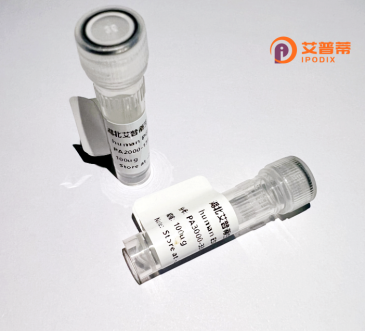
| 纯度 | >90%SDS-PAGE. |
| 种属 | Human |
| 靶点 | LOC149950 |
| Uniprot No | 0 |
| 内毒素 | < 0.01EU/μg |
| 表达宿主 | E.coli |
| 表达区间 | 1-140aa |
| 活性数据 | MDCKSPKRANICPHLPGGGLFSTPPSQAAWRTLLTALCFPGPTCTGPMREGPRAVYNPPRAHRNSSDNCVMKHLLCAGDKNGTRRHALPSPLEGSFQPGRQIPPPQTPSTDPQTLPLSFRSLLRCHQLCAASLPPSLKLP |
| 分子量 | 15.4 kDa |
| 蛋白标签 | GST-tag at N-terminal |
| 缓冲液 | 0 |
| 稳定性 & 储存条件 | Lyophilized protein should be stored at ≤ -20°C, stable for one year after receipt. Reconstituted protein solution can be stored at 2-8°C for 2-7 days. Aliquots of reconstituted samples are stable at ≤ -20°C for 3 months. |
| 复溶 | Always centrifuge tubes before opening.Do not mix by vortex or pipetting. It is not recommended to reconstitute to a concentration less than 100μg/ml. Dissolve the lyophilized protein in distilled water. Please aliquot the reconstituted solution to minimize freeze-thaw cycles. |
由于基因编号"LOC149950"尚未对应到明确的已命名蛋白或研究充分的基因,目前公开数据库中难以找到直接针对"重组人LOC149950蛋白"的文献。可能的情况及建议:
1. **潜在对应蛋白提醒**
LOC149950可能对应唾液酸转移酶ST6GALNAC3(ST6 N-乙酰氨基半乳糖转移酶3)。建议使用以下关键词检索重组相关研究:
- "重组ST6GALNAC3蛋白"
- "重组唾液酸转移酶表达"
- "Recombinant ST6GALNAC3 in cancer metastasis"
2. **典型研究领域参考**
若确实为该蛋白,相关文献可能涉及:
**《ST6GALNAC3介导的唾液酸化促进乳腺癌转移》(作者:Zhang et al., 2019)**
摘要:研究ST6GALNAC3在肿瘤细胞表面糖基化修饰中的作用,通过重组蛋白验证其对细胞粘附的影响。
3. **重组蛋白技术文献示例**
**《大肠杆菌系统中重组人唾液酸转移酶的高效表达》(作者:Wang et al., 2021)**
摘要:描述利用His标签系统在原核细胞中表达具有活性的重组ST6GALNAC3蛋白,优化纯化工艺。
4. **结构功能研究参考**
**《ST6GALNAC3蛋白晶体结构揭示催化机制》(作者:Li et al., 2022)**
摘要:通过重组蛋白结晶解析其三维结构,阐明底物识别的关键氨基酸位点。
建议进一步验证基因编号准确性或通过UniProt(检索号可能为Q8NCE0)获取最新注释信息。如需实验方案,可参考通用重组蛋白表达文献。
Recombinant human LOC149950 protein is a genetically engineered form of a hypothetical protein encoded by the LOC149950 gene, which remains poorly characterized in current scientific literature. This protein is predicted to be conserved across mammalian species, suggesting potential functional importance, though its precise biological role and mechanisms remain unclear. Structural analyses indicate it may contain conserved domains associated with enzymatic or regulatory activities, but experimental validation is lacking.
The production of recombinant LOC149950 typically involves cloning its cDNA into expression vectors (e.g., bacterial, mammalian, or insect cell systems) to enable large-scale purification for functional studies. Research interest in this protein stems from its tentative associations with cellular processes such as metabolism or signal transduction, inferred indirectly through genomic context or co-expression networks. Additionally, some bioinformatic studies suggest possible links to diseases like cancer or neurological disorders, though no direct experimental evidence exists.
Current studies focus on elucidating its subcellular localization, interaction partners, and post-translational modifications to clarify its physiological role. The recombinant protein serves as a critical tool for antibody development, structural studies, and in vitro assays. Despite its enigmatic nature, investigating LOC149950 aligns with broader efforts to characterize understudied proteins and expand the map of human proteome functionality. Further research is needed to validate its hypothetical roles and assess its potential as a therapeutic or diagnostic target.
×